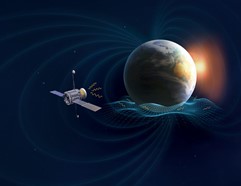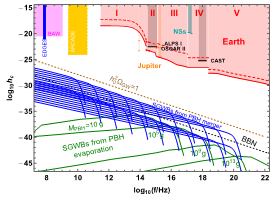Recent Progress on Detecting High-frequency Gravitational Waves in Planetary Magnetospheres
Dr. REN Jing, an Associate Professor in the Theoretical Physics Division at the Institute of High Energy Physics of the Chinese Academy of Sciences, along with her collaborators, has introduced a novel detection strategy for high-frequency gravitational waves (HFGWs) for the first time. They suggest that nearby planets, such as Earth and Jupiter, with their magnetospheres, could serve as giant detectors for HFGWs. Through the analysis of data from existing satellites, their research demonstrates that this method can set promising limits on these waves across a broad spectrum of frequencies. This work has been published in the internationally renowned journal Physical Review Letters (Phys. Rev. Lett. 132 (2024), 131402).
The successful detection of gravitational waves (GWs) by the Laser Interferometer Gravitational-Wave Observatory opens up a window to observe the Universe otherwise inaccessible. This success has spurred a series of ongoing and planned projects aimed at detecting gravitational wave signals below ten thousand hertz. However, HFGWs, potentially generated during the early universe or violent activities of extremely compact astronomical objects, may exist far beyond this frequency range. Their detection could provide crucial clues for exploring new physics beyond the standard model. Due to their shorter wavelengths, it is challenging for laser interferometers to capture these "high notes." One detection method relies on the Inverse Gertsenshtein effect, through which HFGWs are converted into photons in magnetic fields for detection. Considering magnetic fields of great strength or extensive spatial distribution could, to some extent, compensate for the weak gravitational coupling. Existing proposals have considered magnetic fields in various environments, including laboratories, compact stars, or inside and outside galaxies, but the detection efficacy of these schemes is limited by various factors.
Dr. REN Jing and her collaborators have for the first time proposed using planets in the solar system as laboratories for detecting HFGWs. They utilize scientific satellites orbiting the planets to detect signal photons produced by the conversion of gravitational waves in the planet's magnetosphere. Considering the electromagnetic waveband range detected by astronomical observations, this scheme can cover a broader range of gravitational wave frequencies. Additionally, the signal characteristics are closely related to the properties of the waves and the orbital trajectories of the satellites. Compared to other detection methods, this approach also has advantages such as high certainty in magnetic field strength, long paths of effective GW-photon conversion, and a wide angular distribution of signal flux. Their results indicate that using existing low-Earth-orbit satellite data, the planetary magnetosphere system has already been able to impose highly encouraging limits on HFGWs across a wide frequency range, covering a large portion of parameter space that was unexplored before. The study also predicts the sensitivity for future missions. These studies lay the foundation for innovative detection methods and open up a new frontier in our quest to understand the hidden corners of the universe.
The authors of this paper (in alphabetical order) are: Associate Professor LIU Tao from the Hong Kong University of Science and Technology, Associate Researcher REN Jing from the Institute of High Energy Physics, and Postdoctoral Fellow ZHANG Chen from the Hong Kong University of Science and Technology. This work was supported by the Collaborative Research Fund (CRF) of the Research Grants Council of Hong Kong S. A. R., Chinese Academy of Sciences Talent Funds and the National Natural Science Foundation of China.


Figure: a schematic representation of detecting high-frequency gravitational waves (HFGWs) in planetary magnetospheres (left); Projected 95% C.L. upper limits on the characteristic strain of stochastic HFGWs, set by the low Earth orbit satellites (right). The paper link: https://journals.aps.org/prl/abstract/10.1103/PhysRevLett.132.131402
Contact Information
Ms. JIA Yinghua
jiayh@ihep.ac.cn